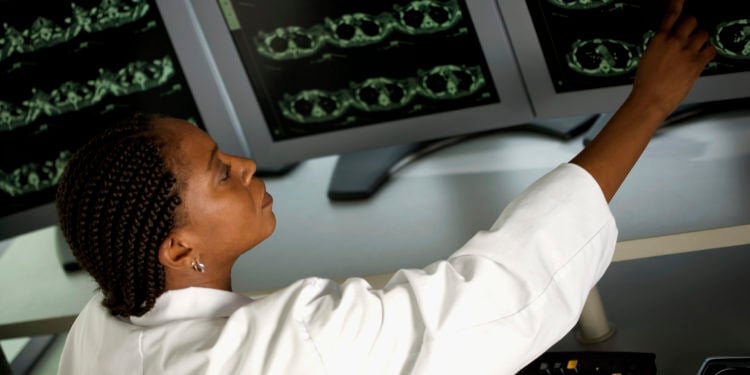
It’s no bigger than a dime, thus inspiring the occasional “lab-on-a-chip” reference, but a tiny blood-analyzing device created by a multidisciplinary team of researchers helmed by the president of Carnegie Mellon University could prove mammoth in helping to bring much-needed relief to people with sickle cell disease.
Like 26-year-old Je’Lisa Glass, who has spent her life wracked with unpredictable bouts of acute pain. Such is the plight of genetics gone awry that includes this native Detroiter among some 25 million individuals worldwide, 100,000 of them here in the United States, who share the disorder she was born with.
“I have had crises all my life,” the budding professional make-up artist shared of lasting pain episodes that are sometimes preceded by a temporary ache in her arms warning her of the excruciation to come. At other times, she’s blindsided by pain in her arms and legs comparable to “being hit with a hammer or bat over and over again.”
And the attacks come far more often as an adult, Glass revealed, than the five or six times a year throughout childhood that they forced her to be hospitalized.
“Just this year alone, I’ve probably been admitted to the hospital twice a month,” she specified one evening four days into a second hospitalization in two weeks.
Glass’ suffering is just what Carnegie Mellon president Subra Suresh and the engineers, biologists, applied mathematicians and clinicians allied with him have spent the past decade honing a diagnostic means to help doctors and researchers better treat and, ultimately, eradicate. Using a technology called microfluidics, Subresh and his team have developed a mechanism to vary the oxygen levels of blood samples and, thus, observe the unique mutation patterns of red cells in people with sickle cell disease.
People with sickle cell disease inherit a deviant gene from each of their parents that combined, causes them to have abnormal hemoglobin, the protein in red blood cells that carries oxygen throughout the body. As a result, their red blood cells that periodically morph from round pliable shapes traveling easily through the body’s small and large blood vessels, into rigid, sickled forms that clump together to block the smallest vessels. This sudden obstruction of oxygen to the body’s tissues can render someone anemic and vulnerable to infections. Plus lead to jaundice, leg ulcers, organ damage and even strokes. And randomly trigger severe pain spells in the arms, legs, chest, stomach, lower back, and joints and bones.
“So far, there is no good way to predict when exactly a pain crisis will occur or how severe it may be,” noted Ming Dao, one of the researchers working with Suresh.
The cross section of researchers who Suresh oversees to help confront this global health challenge join him from the University of Pittsburgh Medical Center, Florida Atlantic University and Brown University. As well as the Massachusetts Institute of Technology, where Dao is a principal in the materials science and engineering department.
Their microfluidic device awaits several patent approvals that could start coming through in 2017, disclosed Suresh, adding that it has even garnered attention from several companies, including a startup, already considering its commercial potential.
Shuichi Takayama, a professor of biomedical engineering at the University of Michigan, pointed out that “all living systems like plants and animals are ‘microfluidic’ in having blood vessels, veins, etc.”
Think, then, of a miniature replica of a living system in which human tissue can be infused to approximate the behavior of whole organs. Allowing “clotting, bleeding, cell adhesion, immune response and inflammation to be measured using a fraction of the blood volume required by traditional assays, at a fraction of the cost,” noted Dr. Patrick Hines.
He launched Functional Fluidics LLC in 2014 to market just such a microfluidic-based diagnostic system that he has developed with fellow researchers, Drs. Jennell White and Xiufeng Gao, as an assistant professor of pediatric critical care medicine at Wayne State University in Detroit.
“Researchers have been developing sophisticated diagnostic tests and biomarkers to predict risk and provide better individualized therapy for cancer patients for years,” noted the physician in the intensive care unit at Children’s Hospital of Michigan as well. “Yet blood function abnormalities [like sickle cell disease] kill more people than any other cause worldwide, and more effective blood function tests are urgently needed.”
Funded in part by the National Institutes of Health, the microfluidic device conceived by Suresh and his team includes a double-layered transparent polymer chip bonded onto a glass slide. Tunneled throughout one layer is a network of “micro-gates” for the cell-containing blood to flow through, while the other layer contains a network for manipulated amounts of oxygen, Dao explained.
A thin plastic membrane separating both sets of channels allows a gas exchange without any blood leaking because the membrane is only gas permeable, he continued. The entire device is mounted onto a microscope. Thin, flexible tubes extending from several ports link it to a pressure controller as well that lets researchers input and output oxygen to observe the sickling rates of red blood cells. The data from this surveillance is recorded on an accompanying computer.
“If I never have another crisis, I feel like I could do so much more, and not have to feel like a failure again,” shared Glass. To be able to predict and, therefore, prevent such bouts of physical agony that, most recently, has prevented her from completing a five-month program began back in February to become a certified cosmetologist, she surmised, would be life changing.
King is a Detroit-area writer, independent filmmaker and actress who carries the genetic trait for sickle cell disease. For more information about her, go to www.squarepegroundholecreation.com.
Link to Original Article:
https://www.jetmag.com/life/sickle-cell-hope/

![Microscopy & microfluidics[2] copy](https://www.functionalfluidics.com/hs-fs/hubfs/Imported_Blog_Media/Microscopy-microfluidics2-copy-300x207.jpg?width=388&height=268&name=Microscopy-microfluidics2-copy-300x207.jpg)

